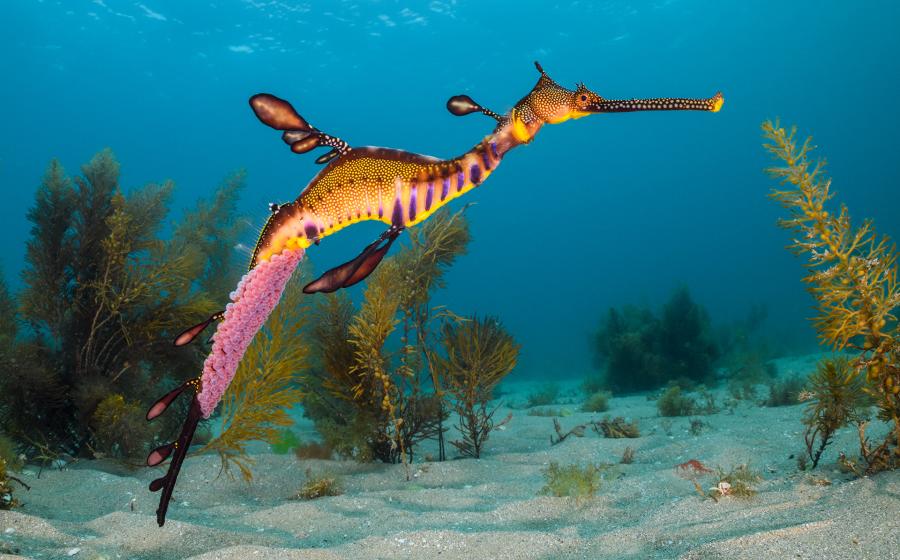Australia

Make no mistake about it: Australia is not a dive destination-it is dozens of dive destinations. In the south, you'll find great white sharks. Out west lies Ningaloo Reef, one of the most dependable spots in the world for encounters with whale sharks. And, of course, off the northeast state of Queensland is the single largest attraction for divers in Australia: the Great Barrier Reef, with 1,200 miles of reefs, cays and islets and the largest marine park in the world.
Boats depart for the Great Barrier Reef from ports and islands up and down the country's eastern coast, including the Whitsunday Islands, Townsville, Cairns, Port Douglas and Cooktown. There are several ways to dive the GBR, allowing you to customize your itinerary based on exactly how much time you want to spend under water. Day boats will let you get two tanks on the reef and be back on land for dinner. Three- and four-day live-aboard trips are great for divers who aren't quite ready to make a weeklong commitment. These cruises offer a few days of solid diving, while leaving travelers plenty of time to explore the region's many natural attractions above water. Then there are full-blown live-aboard cruises that take divers to the outer edge of the Great Barrier Reef or a couple hundred miles out into the remote Coral Sea, for some of the country's best diving.
Dive In
Weather: Seasons are reversed-December through February is summer; June through August is winter. In the tropical north of Queensland, daytime air temps vary from the 80s in winter to the 90s in summer.
Average Water Temp: Expect water temps in the mid-80s in summer throughout the central and northern Great Barrier Reef, but surprisingly cool mid-70s in winter.
Average Visibility: Water clarity inside the Great Barrier Reef is affected by tides and surge and averages 40 to 60 feet, with an occasional high of 100 feet. Outside the reef, visibility averages a reliable 50 to 100 feet and often soars to more than 200 feet out in the Coral Sea.
Currency: Australian dollar (A$).
Time: Queensland is 14 hours ahead of Eastern Standard Time, 17 ahead of Pacific Standard Time.
Direct Dial Code: 011-61.
Language: English.
Electricity: 220/240 volts, 50 cycles. An adapter socket may be necessary.
Entry Documents: A passport and visa are required.
Departure Tax: Departure tax is about $30, but it's usually included in airline ticket prices.
For More Info: Tourism Queensland, www.queenslandholidays.com.au, Tourism Tropical North Queensland, www.tropicalaustralia.com.au, www.australia.com.

Make no mistake about it: Australia is not a dive destination-it is dozens of dive destinations. In the south, you'll find great white sharks. Out west lies Ningaloo Reef, one of the most dependable spots in the world for encounters with whale sharks. And, of course, off the northeast state of Queensland is the single largest attraction for divers in Australia: the Great Barrier Reef, with 1,200 miles of reefs, cays and islets and the largest marine park in the world.
Boats depart for the Great Barrier Reef from ports and islands up and down the country's eastern coast, including the Whitsunday Islands, Townsville, Cairns, Port Douglas and Cooktown. There are several ways to dive the GBR, allowing you to customize your itinerary based on exactly how much time you want to spend under water. Day boats will let you get two tanks on the reef and be back on land for dinner. Three- and four-day live-aboard trips are great for divers who aren't quite ready to make a weeklong commitment. These cruises offer a few days of solid diving, while leaving travelers plenty of time to explore the region's many natural attractions above water. Then there are full-blown live-aboard cruises that take divers to the outer edge of the Great Barrier Reef or a couple hundred miles out into the remote Coral Sea, for some of the country's best diving.
Dive In
Weather: Seasons are reversed-December through February is summer; June through August is winter. In the tropical north of Queensland, daytime air temps vary from the 80s in winter to the 90s in summer.
Average Water Temp: Expect water temps in the mid-80s in summer throughout the central and northern Great Barrier Reef, but surprisingly cool mid-70s in winter.
Average Visibility: Water clarity inside the Great Barrier Reef is affected by tides and surge and averages 40 to 60 feet, with an occasional high of 100 feet. Outside the reef, visibility averages a reliable 50 to 100 feet and often soars to more than 200 feet out in the Coral Sea.
Currency: Australian dollar (A$).
Time: Queensland is 14 hours ahead of Eastern Standard Time, 17 ahead of Pacific Standard Time.
Direct Dial Code: 011-61.
Language: English.
Electricity: 220/240 volts, 50 cycles. An adapter socket may be necessary.
Entry Documents: A passport and visa are required.
Departure Tax: Departure tax is about $30, but it's usually included in airline ticket prices.
For More Info: Tourism Queensland, www.queenslandholidays.com.au, Tourism Tropical North Queensland, www.tropicalaustralia.com.au, www.australia.com.






